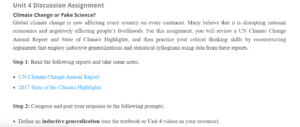Inductive Generalization and Statistical Syllogism
Inductive generalization
Inductive generalization entails reasoning from instances. Inductive reasoning based on what is acknowledged develops new information. The correct way to generate inductive generalization is to ensure the claim satisfies both the correct arrangement and overall evidence conditions.
Deforestation and forest degradation account for about 17% of global carbon dioxide emissions.
Therefore, deforestation and degradation cause carbon dioxide emissions.
Inductive generalization relies on probabilities or observations. However, this reasoning does not necessarily make the claim and conclusion factual.
Statistical syllogism
Statistical syllogism is a non-deductive syllogism that applies inductive reasoning from a generalization true for the substantial section of a specific case. The premises may utilize qualifying words such as “rarely” and “frequently” or demonstrate statistical generalization as one or both of their premises.
From 2015 to 2017, 26 of 38 developing nations had submitted reference levels.
Kenya is a developing country.
Kenya has submitted reference levels.
The first premise is a generalization, and the claim tries to draw a conclusion from the generalization. The overall argument demonstrates that the syllogism is inductive. Therefore, when assessing this type of claim, the writer should be careful to emphasize how strong or weak it is, in addition to other induction rules.
ORDER A PLAGIARISM-FREE PAPER HERE
We’ll write everything from scratch
Question
Unit 4 Discussion Assignment
Climate Change or Fake Science?
Global climate change is now affecting every country on every continent. Many believe that it is disrupting national economies and negatively affecting people’s livelihoods. For this assignment, you will review a UN Climate Change Annual Report and State of Climate Highlights, and then practice your critical thinking skills by reconstructing arguments that employ inductive generalizations and statistical syllogisms using data from these reports.

Inductive Generalization and Statistical Syllogism
Step 1: Read the following reports and take some notes.
Step 2: Compose and post your response to the following prompts:
- Define an inductive generalization (use the textbook or Unit 4 videos as your resource).
- Reconstruct (or simply create, using standard form) an argument using the characteristic pattern of an inductive generalization that references data from one of the reports. (Be sure to cite your sources properly, using APA )
- Evaluate your argument in terms of the criteria for acceptable inductive
Does it satisfy the criteria? Explain why.
- Define a statistical syllogism (use the textbook or video as your resource).
- Reconstruct (or simply create, using standard form) an argument using the characteristic pattern of a statistical syllogism that references data from one of the reports. (Again, be sure to cite your sources properly, using APA )
- Evaluate your argument in terms of the criteria for acceptable statistical syllogisms. Does it satisfy the criteria? Explain why.
Step 3: Peer Response — Is climate change “fake” science? Is climate change just a hoax?
You’ve probably heard some opinions that climate change is nothing but a hoax based on “fake” science. Before you respond to your classmates in this Discussion Forum, read a few of these views and then attempt to detect some habits of good and bad thinking within them. Here are several samples — or find your own (there are many out there!):
https://calthomas.com/columns/climate-change-hoax-exposed https://en.wikipedia.org/wiki/Global_warming_conspiracy_theory
Step 4: Once you’ve perused these articles, do the following in your responses to other students:
- Identify the most obvious habits of bad thinking/questioning (or good thinking/ questioning, if you feel that global climate change is a hoax) that the articles reveal. Use the list of good/bad habits of thinking/questioning that follows below as a
- State your own view on global climate change. Is it real? On a scale of 1-5, with 5 being the most important, how would your rate the importance of addressing climate change? What steps, if any, are you taking in your own life to address the problem?
Bad Habits of Thinking:
- Self-Interest
- Saving Face
- Peer Pressure
- Stereotyping and Prejudice
- Excessive Skepticism
- Intellectual Laziness
- Relativism (Subjective or Cultural)
Good Habits of Critical Thinking
- Be Curious
- Be Self-aware
- Be Healthy
- Be Courageous
- Be Reasonably Skeptical
- Think for Yourself
- Keep it Simple
- Be Precise
- Be Patient
- Be Consistent
- Be Open-Minded
- Ask for Help
Bad Questions:
- Rhetorical Questions
- Leading Questions
- Loaded Questions
- Obstructionist Questions
- Framing Questions
- Empty Questions
Good Questions:
- Direct
- Useful
- Open and Creative
Recommendations for Success and Grading Criteria
- Respond to the assignment with clear and detailed
- Follow all assignment prompts and answer all prompt
- Incorporate relevant examples and evidence to support your
- Compose your response in clear and grammatically correct English and post it on time.
- Respond to at least two students with substantive comments and follow-up
- Acknowledge all students who comment on your

